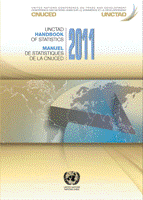
The UNCTAD Handbook of Statistics provides essential data for analysing and measuring world trade, investment, international financial flows and development. Reliable statistical information is often considered as the first step during the preparation of making recommendations or taking decisions that countries will commit for many years as they strive to integrate into the world economy and improve the living standards of their citizens. Whether it is for research, consultation or technical cooperation, UNCTAD requires comparable, often detailed economic, demographic and social data, over several decades and for as many countries as possible.
In addition to facilitating the work of the secretariat’s economists, the UNCTAD Handbook of Statistics also enables other users, such as policymakers, research specialists, academics, officials from national governments or international organizations, executive managers or members of nongovernmental organizations(NGOs) from developing, transition or developed countries to have access to thisrich statistical information. The Handbook further offers journalists comprehensiveinformation in a presentation that meets their needs.
The UNCTAD Handbook of Statistics 2011 provides users with reliable coherent data on the following subjects:
- International merchandise trade: values, trends and regional trade zones
- Export and import structure by products and by regions of origin and destination, and related concentration and diversification indices
- Volume and terms of trade indices
- Average applied import tariff rates
- Trade in services: total trade and trade by sector
- Maritime transport: world merchant fleet
- Commodity prices and relevant price indices; production and processing of selected raw mineral commodities
- International financial data: current accounts, capital and financial accounts, foreign direct investment, external indebtedness, workers’ remittances, etc
- Indicators of development: GDP, population and labour, and selected development indicators
Particular acknowledgement is due to the Statistics Division of the Department of Economic and Social Affairs of the United Nations, as well as to other international organizations, for its help in preparing this publication.



